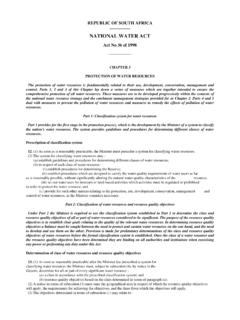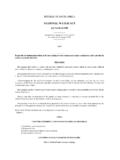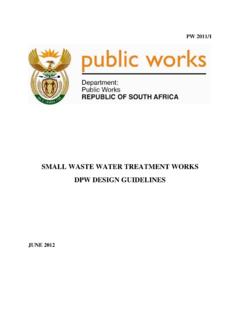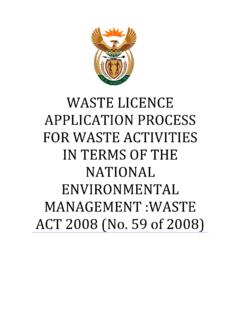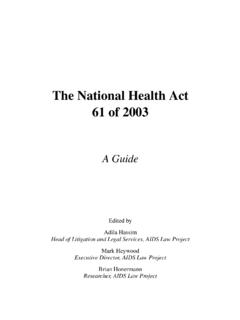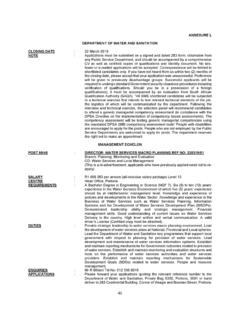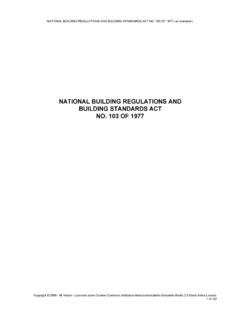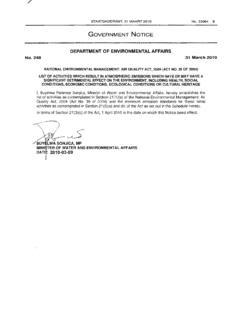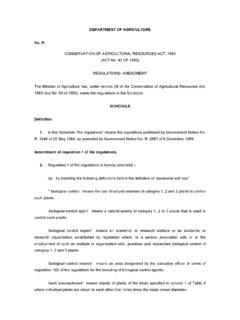Transcription of Eberhard administered prices Session 3B - National Treasury
1 administered prices water A report for National Treasury ROLF E Eberhard Preface This report was prepared for National Treasury to support its assessment of administered prices in South Africa. The objective of the study was to assess the processes involved in setting prices in regulated industries. By evaluating the efficiency, effectiveness and analytical rigour of the regulatory processes involved in setting prices for the services involved, an assessment can be made of the likelihood that the resultant tariffs approach efficient levels. Volume I of the report sets out the main findings and recommendations with supporting information relating to the individual sectors included within the scope of the study provided in a summarised form. Volume II contains more detailed sectoral reports, covering individual review of the water , electricity, telecommunications, transport, health and education sectors.
2 The report does not offer a detailed quantitative assessment of the performance of the regulatory regime, and is largely based on in-depth interviews and documentary analysis. The authors would like to thank the interviewees for their cooperation and valuable insights. Although much care was taken to provide a correct reflection of the opinions expressed, the authors remain entirely responsible for any inaccuracies. CONTENTS EXECUTIVE SUMMARY 1 THE water SERVICES SECTOR IN SOUTH AFRICA AN OVERVIEW 6 1. INTRODUCTION 8 2. THE INSTITUTIONAL FRAMEWORK 9 3. THE FINANCIAL FRAMEWORK 11 4. THE PRICING FRAMEWORK 13 The Cost and Pricing Chain 13 Tariff Policy 13 Setting and Regulating Price Levels 16 5. CURRENT PRICING PRACTICES AND INCENTIVES 19 Qualitative Assessment of Pricing Incentives 19 Illustrations of Incentive Effects 23 6. REFORM INITIATIVES 30 7. CONCLUSIONS 32 8.
3 RECOMMENDATIONS 34 REFERENCES 36 APPENDIX 1: LIST OF RELEVANT POLICIES AND LEGISLATION RELATING TO water SERVICES 37 APPENDIX 2: DEFINITIONS 38 APPENDIX 3: TARIFF POLICIES FOR water SERVICES 40 APPENDIX 4: DRAFT GUIDELINES FOR BULK water SERVICES TARIFF SETTING BY water BOARDS DEPARTMENT OF water AFFAIRS AND FORESTRY 43 APPENDIX 5: DWAF water RESOURCE PRICING STRATEGY KEY ELEMENTS 45 LIST OF FIGURES Figure 1: The financial framework .. 11 Figure 2: water cost and pricing chain .. 13 Figure 3: Map of pricing incentives .. 19 Figure 4: Average retail water and bulk water prices are diverse - an illustration .. 23 Figure 5: water resource tariffs for municipal use (c/kl).
4 24 Figure 6: water resource tariffs for irrigation use (Rands per hectare).. 24 Figure 7: Trends in water resource tariffs for municipal use .. 25 Figure 8: Trends in water resource tariffs for 25 Figure 9: Trends in bulk water tariffs for selected water boards .. 26 Figure 10: Umgeni Financial Performance .. 27 Figure 11: Average domestic retail tariffs for 20 kl per month (nominal).. 27 Figure 12: Average domestic tariff for 50 kl per month (nominal) .. 28 Figure 13: Rate of nominal change in average household tariffs for 20 kl per month .. 28 Figure14: Rate of nominal change in average household tariff for 50 kl per month .. 29 Figure15: Nominal bulk and retail tariff increases in Mangaung .. 29 LIST OF TABLES Table 1: Responsibilities for Tariff Policy 14 Table 2: Responsibilities for Tariff Setting 17 LIST OF ACRONYMS CMA Catchment management agency DPLG Department of Provincial and Local Government DORA Division of Revenue Act 5 of 2002 DWAF Department of water Affairs and Forestry ES The local government equitable share kl kiloliter (one thousand litres) IG Municipal infrastructure grant NT National Treasury WSA water services authority WSP water services provider 1 EXECUTIVE SUMMARY Institutional framework There are many different players in the provision of water and sanitation services in SA.
5 The water sector does not have a distinct or independent regulator. Department of water Affairs and Forestry (DWAF) Custodian of water resources and overall policy maker and regulator (there is no independent regulator) Oversees the activities of all water sector institutions Responsible for National /international resource planning and allocation Licenses water use and discharges and collects abstraction and discharge fees Manages water resources infrastructure (for example, dams) and also some water services infrastructure Catchment Management Agencies (CMAs) water resource planning and management at the catchment level (where CMAs are not established, DWAF fulfils these functions) water Services Authorities (WSAs) Provision of water services within their appointed areas. Includes metropolitan municipalities, many district municipalities and authorised local municipalities.
6 May contract out service provision to external water services providers. water Services Providers (WSPs) Operational water provision and/or sanitation services (as a bulk or retail service) water Boards (WBs) Regional or bulk water services providers (sell water to, or accept wastewater from, other water services providers). As WSPs, the Boards are accountable to WSAs; as organs of state, the Boards are owned, controlled and regulated by DWAF and National Treasury (NT) under the terms of the water Services Act, 1998 and the Public Finance Management Act, 1999. In this setting, ministerial discretion is high, although actual involvement is low as DWAF, which reports directly to the Minister, is both the sector policy maker and regulator. A key characteristic of the sector is the diversity of WSPs in terms of both scale and type: a water services provider could serve one small rural community, one or more towns, a large metropolitan area or a whole region; it might be a community-based organisation, a local municipality, a district municipality, a public utility (owned by local and/or National government), or a private The sector is further characterised by public ownership and control (at the National and municipal level) and limited participation by private companies.
7 Where there is private participation, for example, the Dolphin Coast and Nelspruit concessions, the ownership of the water services assets has remained in public hands. 1 This is not an exhaustive list of possible arrangements. 2 Regulatory framework There is a marked absence of any formal economic regulation of water tariffs throughout the water cost chain and no formal economic regulatory function exists in any part of the water sector. Self-regulation is evident in a number of instances: that is, the same institution both sets the tariff level and regulates the tariff level. The final charges paid by water service end-users incorporate a number of different elements that are themselves regulated in different ways and by different entities. As a consequence, it is extremely unlikely that the end charges bear any systematic relationship either to costs or to the achievement of wider social objectives that are of key importance in setting water charges.
8 The following is a brief overview of the prices involved in the water activity chain: water resource prices Apply to water supplied by government water schemes (GWSs) and other water management institutions which include CMAs and water user associations (WUAs) Separated into two basic components: o The water resources management charge (intended to cover the costs of catchment management activities) Set by CMAs (or DWAF where there is no CMA). Tariff should be cost-reflective but there is no formal regulation of costs or the charge. o The water resources development charge (reflecting DWAF s broader water resource pricing strategy) Set by DWAF. Tariff policy requires a 4% real return on the depreciated current value of assets (to be implemented progressively from a low base). This policy is considered by some to imply extraction of monopoly rent by DWAF at the expense of the WSAs and to be an abuse of its self-regulatory status.
9 The evidence suggests that the charge is still at below full cost recovery level, however. DWAF s overall water resource pricing strategy is aimed at moving towards tariffs which recover the full economic costs of providing raw water from the resource, whilst maintaining subsidies for poorer consumers and emerging farmers. DWAF is both price setter and regulator (for its own schemes) and has an incentive to increase prices , although in practice actual prices are in many cases set below the rate allowed by the policy. There are no incentives to cut costs or improve efficiency. 3 Bulk water tariffs prices for bulk water provided by water boards are set by water boards themselves, subject to ministerial approval. o Bulk tariffs set inconsistently by WBs and with a lack transparency o No explicit policies exist although a draft guideline has been developed by DWAF. Charges generally cost-plus but there is no formal economic regulation of prices , and no guidelines for allowed costs, rate of return etc exist.
10 There are no incentives to cut costs or improve efficiency. o Main constraint in practice is DWAF s insistence that charges changes should, if at all possible, be consistent with government inflation targets. WBs required to justify larger increases in terms of promotion of contribution to key objectives (social equity, financial sustainability, water demand management, direct costs of augmentation) as well as the impact of changes in demand projections. prices for bulk water provided by other agencies, such as WSAa, also not formally regulated. Where WSAs manage their own bulk supplies, costs (and price) are subsumed in their retail tariffs. Where WSAs provide bulk water to other WSPs, price and other terms are negotiated between the parties. water services tariffs (retail prices ) High level principles for tariff setting are included in Municipal Systems Act and the water Services Act o Tariffs to be cost based and take into account equity and sustainability considerations, and principles of proportionality; o All forms of subsidy should be fully disclosed Little guidance provided on the practical application of these principles Significant risk that pressure from municipalities to constrain charges increases below inflation has resulted in final charges being progressively squeezed to below full cost recovery level ( below the level necessary to enable full maintenance of infrastructure).










